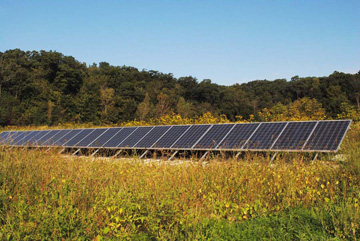Wisconsin's Initiative for Sustainable Remediation and Redevelopment (WISRR)
Sustainable cleanups, or "greener" cleanups, are fast becoming a hot topic in the world of environmental contamination remediation. The DNR's Remediation and Redevelopment (RR) Program is working to foster environmentally friendly practices through the Wisconsin Initiative for Sustainable Remediation and Redevelopment (WISRR).
The WISRR initiative continues the RR Program's history and spirit for applying innovation to a strong foundation of environmental protection and economic benefit. Formerly known as the Wisconsin Initiative for Sustainable Cleanups (WISC), this effort emphasizes the applicability of sustainable technologies in site remediation and encourages the use of green technology during the redevelopment process. Saving energy, reducing greenhouse gases and minimizing waste through reuse and recycling are all aspects of WISRR.
By applying WISRR concepts to the cleanup and redevelopment of contaminated properties, Wisconsin's citizens will be rewarded with remedies that are protective of public health, safety and the environment, and are also economically sound and more sustainable to meet long-term needs and protect valuable state resources.
Green and sustainable remediation manual
Environmental professionals can implement sustainable remediation practices at cleanup sites by using the WISRR Green and Sustainable Remediation Manual. The manual was drafted by an external contract under the guidance of the WISRR Team. A companion document examines real-world applications of the WISRR Manual at state-led remediation sites.
Quick reference guides
Pilot project: Refuse hideaway solar array
The RR Program's first pilot project is the former Refuse Hideaway Landfill [PDF], in the town of Middleton. The former landfill is a Superfund site, currently in the joint care of the U.S. EPA and DNR. Remediation systems have been running at the site for more than 20 years, using a substantial amount of energy.
In 2010, a 44-panel solar array was installed at the site to generate clean energy. The array off-sets one-fourth of the energy used to power the remediation systems. The RR Program will look at expanding this model for other state- and privately-owned sites once the results of the project can be examined.
Additional resources
- ASTM Guide for Greener Cleanups (E2893) [exit DNR]*
- ASTM Guide for Integrating Sustainable Objectives into Cleanup (E2876-13) [exit DNR]*
- U.S. EPA's Green Remediation [exit DNR]
- Illinois EPA's Greener Cleanups [exit DNR]
- RE-Powering America's Land - Siting Renewable Energy on Potentially Contaminated Properties: Liability Considerations - This EPA fact sheet provides answers to common questions raised by developers of renewable energy projects on contaminated properties.
*Note: there is a fee to download ASTM documents

